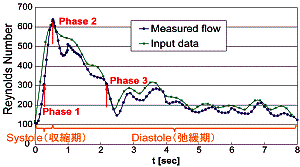Time-resolved Stereo PIV Measurement of Pulsatile Flow in the Modeled Artery
We aims to investigate the behavior of pulsatile blood flow in the curved pipe (Fig. 1) that assimilates the Internal Carotid Artery (ICA), which is one of preferential locations of an aneurysm. Since complicated secondary flow arises due to curvature of artery, the PIV (Particle Image Velocimetry) is applied to obtain detailed flow information of in vitro experiments. However, the blood flow in the artery is pulsatile (fig. 2) and time-resolution of the conventional PIV is not enough to capture transient behavior of pulsatile flow. Thus, the time-resolved PIV, which consists of high-speed cameras and high repetition rate lasers, is applied to measure unsteady flow (fig. 3). Since this new measuring method can provide superior resolution in space as well as in time.
The resolution in space is also improved from two-dimensional PIV system to stereo PIV system. In order to perform stereo calibration at a narrow and complex measurement area, we developed non-invasive stereo calibration technique using laser beams.
Fig. 1 Curved model assimilated ICA and Measuring sections of PIV
Fig. 2 Inlet pulsatile flow waveform
Fig. 3 Picture of experimental setup
Figure 4 shows the result of 2D time-resolved PIV measurement. The mainstream flow profile changes drastically in flow inside curved pipe due to pulsation. Especially, the separation region is formed during diastole, it turns out that expansion and the reverse flow promotes and more complicated structure is formed. Moreover, the secondary flow pattern at the systole and diastole phases are completely different, and the balance change of the vorticity magnitude relationship between the inner vortex and the outer vortex is very complex.
Fig. 4 Secondary flow pattan at each cross section and main flow pattern at vertical section
Fig. 5 2D-3C flow structure measured by Stereo PIV (Sec.B)
Figure 5 shows the result of stereo time-resolved PIV measurement, two-dimensional three-components transient flow structure is observed. Pairs of secondary flow vortex have different momentum and they affect each other intricately. The flow characteristics at the systole phase are drastically different from those at the diastole phase even with the same Reynolds number.
References
Oishi, M., Oshima, M. and Kobayashi, T. High-speed PIV Measurement of Blood Flow in the Modeled Artery. Proceedings of PSFVIP-4, Chamonix France, Paper No.F4098, 2003.
Oishi, M., Oshima, M. and Kobayashi, T. PIV Measurement of Flow in the Modeled Artery using High Speed Camera. Proceedings of the 7th Asian Symposium on Visualization, Singapore, 2003
大石正道, 大島まり, 佐賀徹雄, 小林敏雄, Dynamic PIV を用いた血管モデル内拍動流の時系列計測, 可視化情報Vol.24, Suppl. No.2,可視化情報全国講演会(愛媛2004), pp.165-168
Oishi, M., Oshima, M. Saga, T. and Kobayashi, T. Dynamic PIV Measurement of Pulsatile Flow in the Modeled Artery. Proceedings of 11th International Symposium on Flow Visualization, Notre Dame, Indiana, USA, Paper No.099, 2004.
M. Oishi, M. Oshima, Y. Bando, T. Kobayashi, Time-resolved Stereo PIV Measurement of Pulsatile Flow in the Modeled Artery, The 5th Pacific Symposium on Flow Visualization and Image Processing, 2005, Australia, pp. 63-64





